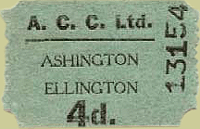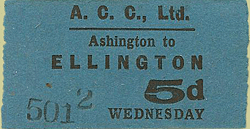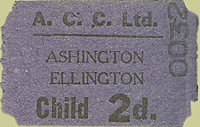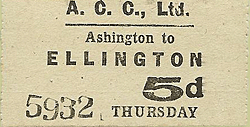
Station Name: HIRST PLATFORM (Ashington Colliery)
[Source:
Alan Young]
| Date opened: |
1895, or later |
| Location: |
North of Rotary Parkway, east side of the Wansbeck Business Park |
| Company on opening: |
Ashington Coal Company |
| Date closed to passengers: |
16.5.1966 |
| Date closed completely: |
16.5.1966 |
| Company on closing: |
National Coal Board |
| Present state: |
Demolished |
| County: |
Northumberland |
| OS Grid Ref: |
NZ271881 |
| Date of visit: |
23.5.2012 |
Note: This was the southern terminus of the ‘Paddy trains’ which operated on the Ashington Coal Company (later National Coal Board) system northwards to New Moor and either Linton Colliery or Ellington Colliery.
Hirst Platform was shown simply as 'Ashington' on tickets.
 |
Hirst Platform was reached by footpath from the north end of Council Road which followed the east-west line from Ashington ‘main line’ station, before crossing it via a footbridge, where the passengers were delivered to the head of the platforms. There were two side-platforms, over 300ft in length, and a central line between the two serving the platforms to allow locos to be removed from their trains. OS 1:2500 maps published between |
1923 and 1959 show the platforms, though only the 1959 edition specifically names them as ‘platform’.
By 1974 the platforms had been removed. Ashington Colliery closed in October 1986.
BRIEF HISTORY OF THE ASHINGTON COAL COMPANY (later NCB) RAILWAYS
The Ashington Coal Company operated pits at Ashington, Linton, Ellington, Woodhorn and (from 1934) Lynemouth. In 1947 the company’s pits became part of the nationalised coal industry (the National Coal Board).

| From 1880 a 2ft gauge line operated to carry miners from Ashington to Pegwood Colliery. In 1895 this was abandoned in favour of the standard gauge network as this expanded, though not between Ellington and Lynemouth or Ashington and Woodhorn. The service was operated by the colliery company using a variety of ex-railway company stock, from four- and six-wheel coaches, eventually to bogie stock. On occasions |
 |
before World War I the NER provided a locomotive and crew from their North Blyth depot when a colliery locomotive was not available.
 |
The so-called ‘Paddy trains’ began from Hirst Platform, named after the hamlet around which the town of Ashington grew. A 24-hour, 7-days a week service was operated, with about 100 trains on each weekday, 70 on Saturdays and 45 on Sundays. Besides the miners the trains also carried fare-paying passengers at a very cheap rate, whilst children paid half fare, unless going to school, when they travelled |
free. Paper tickets were issued, with a different colour for each day.
| A loco shed served the system. It was located close to Ashington Colliery at NZ 263881. At ‘vesting day’ when Ashington Coal Company became part of the National Coal Board the system ran from Ashington Colliery northwards for 2½ miles (double-track) to Linton Colliery, where the railway’s workshops were situated. Just south of the colliery was Potland |
 |
Junction, whence a further double track section ran north-eastwards for 1½ miles to Ellington Colliery, followed by a single line of 2 miles to Lynemouth Colliery.
 |
The line was fully signalled and track circuited to allow British Railways’ locomotives to work over the system. North of the terminus at Hirst Platform, trains served New Moor platform, about 1 mile north-north-west, and Linton; alternatively trains operated between Hirst and Ellington. The NCB soon stopped carrying children and the general public, limiting the service to |
miners only. In 1965, the year before the service was withdrawn, 95 journeys were run on weekdays and 43 on Saturdays.

The ‘Paddy train’ service was discontinued on 16 May 1966 and replaced with contract buses. All of the pits belonging to the former Ashington Coal Company have now closed.
Click here for a list of sources and a Blyth & Tyne bibliography
Ticket from Michael Stewart. Route map drawn by Alan Young. Timetable from Glen Kilday
To see other stations on the Ashington Colliery Railway click on the station name: New Moor, Linton Colliery & Ellington Colliery |
old2colliery.jpg) Hirst Platforms, Ashington, with 0-6-0 No.12 and a set of four 6-wheel coaches. In the background an aerial ropeway is visible with two containers carrying spoil to the pit heap.
colliery.jpg)
1958 1:2500 OS Map. Ashington consisted of numerous rows of terraced houses built for miners who worked in the town’s colliery and in others owned by the Ashington Coal Company. An intensive service of trains enabled miners to travel between Ashington and three other collieries. The Ashington terminus was Hirst Platform, on a short double-track spur off the mineral line to New Moor, Linton, Ellington and Lynemouth. Access to these platforms was via the footpath shown north of Council Road and the footbridge which crossed over the mineral lines to Ashington Colliery and to the East Coast main line.
Hirst Platform, Ashington, looking south-east in April 1952. A three coach ‘paddy’ train stands at the east platform.
Copyright photo by Richard Casserley
old1colliery.jpg) Miners alight from a train at the north-east platform at Hirst. The lines to the left connect Lynemouth, Ellington and Linton with the passenger line immediately north of Ashington station, just off the left side of the photograph.
Miners alight from a train at the north-east platform at Hirst. The lines to the left connect Lynemouth, Ellington and Linton with the passenger line immediately north of Ashington station, just off the left side of the photograph.
Photo by Ernie Breck from Ernie's Railway Archive
colliery_old7.jpg)
The earliest use of passenger trains within the Ashington collieries was on a 2ft gauge line. This view shows a train hauled by ‘Bothal’, most likely on the first day of service in 1880.
_colliery_old6.jpg)
Ashington Colliery possessed a complex network of sidings. This view dates from before July 1912.
Copyright photo from John Alsop collection
_colliery_old5.jpg)
A five-coach miners’ train on the Ashington Coal Company’s railway prior to 1920. The massive pit heap in the background is supplied with spoil from the pit in small trucks via a waggonway projecting above its summit.
Copyright photo from John Alsop collection
.
_colliery_old4.jpg)
In March 1966, two months before the ‘paddy’ trains ceased to run, a three-coach train passes through a landscape of colliery waste close to Hirst Platforms (Ashington). NCB No31 was built at Robert Stephenson and Hawthorn works in 1950. It was taken out of use at Whittle Colliery in June 1972. The loco was sold nine months later to the North Yorkshire Moors Railway for preservation. It later acquired the name 'Meteor'. It has now moved to the East Somerset Railway where it is being fully restored.
Photo by John Wiltshire
colliery_old8.jpg)
On 10 June 1967 the SLS/MLS 'Ashington railtour' visits the Ashington collieries. The borrowed National Coal Board locomotive 0-6-0T No.39 is hauling a brake van and three NCB coaches. NCB saddle tank No 39 was built in 1938 at Robert Stephenson and Hawthorn works. It arrived at Foxfield in February 1970 for preservation from NCB Gedling Colliery in Nottinghamshire. Three years later it moved to the Great Central Railway where its restoration to working order was completed, including the replacement of the saddle tank with side tanks and repainting in full lined GCR livery. It has since moved to the Darlington Railway Preservation Society but is no longer in working order.
Photo from Martin Bairstow collection
Looking north-west on the site of the tracks between the two Hirst platforms in May 2012. The Ashington Colliery site (off the photograph, to the left) and the former site of the freight line to Ellington (right) which has been realigned a short distance to the east, have been reclaimed and
transformed into a Country Park.
Photo
by Roy Lambeth
2.jpg)
Looking south-east along the site of the former north-east platform at Hirst (Ashington) in May 2012. The woodland, to the left, has been planted on the former trackbed of the Ashington – Ellington freight railway which has been realigned a short distance to the east.
Photo
by Roy Lambeth
Click on thumbnail to enlarge
| Last
updated: Sunday, 21-May-2017 11:12:29 CEST |
© 1998-2012 Disused Stations
| |

old2colliery.jpg)
colliery.jpg)
old3colliery.jpg)
old1colliery.jpg)
_colliery_old5.jpg)
_colliery_old4.jpg)
colliery_old8.jpg)
1.jpg)
2.jpg)










colliery_old7.jpg)
_colliery_old6.jpg)




 Home Page
Home Page